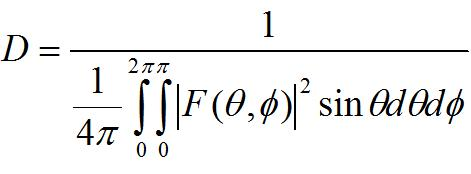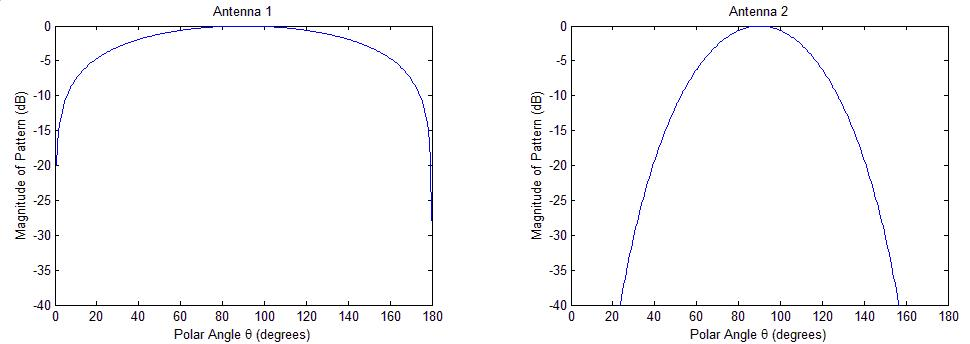Directivity is a fundamental antenna parameter. This is a measure of how the radiation pattern of a directional antenna is. An antenna that radiates equally in all directions will have a directivity equal to 1. (This is equivalent to zero decibels -0 dB).
The function of spherical coordinates can be written as a normalized radiation pattern:

[Equation 1]
A normalized radiation pattern has the same shape as the original radiation pattern. The normalized radiation pattern is reduced by magnitude such that the maximum value of the radiation pattern is equal to 1. (The largest is equation [1] of "F"). Mathematically, the formula for directionality (type "D") is written as:


This may seem like a complicated directional equation. However, the radiation patterns of molecules are of greatest value. The denominator represents the average power radiated in all directions. The equation is then a measure of the peak radiated power divided by the average. This gives the antenna directivity.
Directional paradigm
As an example, consider the next two equations for the radiation pattern of two antennas.

Antenna 1

Antenna 2
These radiation patterns are plotted in Figure 1. Please note that the radiation mode is only a function of the polar angle theta(θ)The radiation pattern is not a function of azimuth. (The azimuthal radiation pattern remains unchanged). The radiation pattern of the first antenna is less directional, then the radiation pattern of the second antenna. Therefore, we expect the directivity to be lower for the first antenna.

figure 1. Radiation pattern diagram of an antenna. Has high directionality?
Using formula [1], we can calculate that the antenna has higher directivity. To check your understanding, think about Figure 1 and what directionality is. Then determine which antenna has higher directivity without using any math.
Directional calculation results, use formula [1]:
Directional antenna 1 calculation, 1.273 (1.05 dB).
Directional antenna 2 calculation, 2.707 (4.32 dB).
Increased directivity means a more focused or directional antenna. This means that a 2-receiving antenna has 2.707 times the directional power of its peak than an omnidirectional antenna. Antenna 1 will get 1.273 times the power of an omnidirectional antenna. Omnidirectional antennas are used as a common reference even though no isotropic antennas exist.
Cell phone antennas should have a low directivity because signals can come from any direction. In contrast, satellite dishes have high directivity. A satellite dish receives signals from a fixed direction. As an example, if you get a satellite TV dish, the company will tell you where to point it and the dish will receive the desired signal.
We will end with a list of antenna types and their directivity. This will give you an idea of what directionality is common.
Antenna type Typical directivity Typical directivity [decibel] (dB)
Short dipole antenna 1.5 1.76
Half-wave dipole antenna 1.64 2.15
Patch (microstrip antenna) 3.2-6.3 5-8
Horn antenna 10-100 10-20
Dish antenna 10-10,000 10-40
As the data above shows antenna directivity varies greatly. Therefore, it is important to understand the directivity when selecting the best antenna for your specific application. If you need to send or receive energy from multiple directions in one direction then you should design an antenna with low directivity. Examples of applications for low directivity antennas include car radios, cell phones, and computer wireless Internet access. Conversely, if you are doing remote sensing or targeted power transfer, then a highly directional antenna will be required. Highly directional antennas will maximize the transfer of power from the desired direction and reduce signals from unwanted directions.
Suppose we want a low directivity antenna. How do we do this?
The general rule of antenna theory is that you need an electrically small antenna to produce low directivity. That is, if you use an antenna with a total size of 0.25 - 0.5 wavelength, then you will minimize the directivity. Half-wave dipole antennas or half-wavelength slot antennas typically have less than 3 dB directivity. This is as low as a directionality that you can get in practice.
Ultimately, we cannot make antennas smaller than a quarter wavelength without reducing the efficiency of the antenna and the bandwidth of the antenna. Antenna efficiency and antenna bandwidth will be discussed in future chapters.
For an antenna with high directivity, we will need antennas of many wavelength sizes. Such as satellite dish antennas and horn antennas have high directivity. This is partly because they are many wavelengths long.
why is that? Ultimately, the reason has to do with the properties of the Fourier transform. When you take the Fourier transform of a short pulse, you get a broad spectrum. This analogy is not present in determining the radiation pattern of an antenna. The radiation pattern can be thought of as the Fourier transform of the distribution of current or voltage along the antenna. Therefore, small antennas have broad radiation patterns (and low directivity). Antennas with large uniform voltage or current distribution Very directional patterns (and high directivity).
E-mail:info@rf-miso.com
Phone:0086-028-82695327
Website:www.rf-miso.com
Post time: Nov-07-2023







